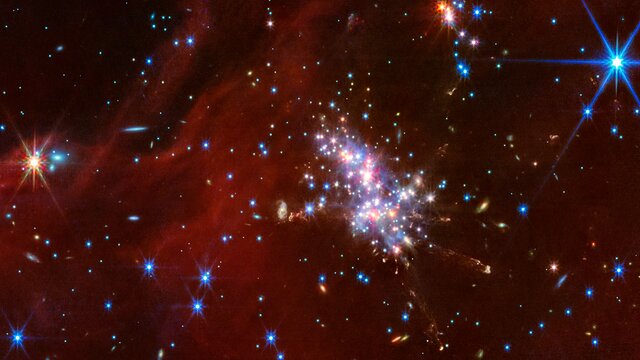weic2422 — Photo Release
Webb peers into the Extreme Outer Galaxy
12 September 2024
Within the Milky Way’s outskirts is a firecracker show of star formation. The NASA/ESA/CSA James Webb Space Telescope has examined the fringes of our Milky Way galaxy and Webb’s near- and mid-infrared imaging capabilities have enabled scientists to examine a star-forming area reminiscent of our galaxy during its early stages of formation.
Astronomers have directed the NASA/ESA/CSA James Webb Space Telescope to examine the outskirts of our Milky Way galaxy, a region scientists call the Extreme Outer Galaxy owing to its location more than 58 000 light-years away from the Galactic centre. For comparison, Earth is approximately 26 000 light-years from the centre.
A team of scientists used Webb’s NIRCam (Near-Infrared Camera) and MIRI (Mid-Infrared Instrument) to image selected regions within two molecular clouds known as Digel Clouds 1 and 2. Thanks to its high sensitivity and sharp resolution, Webb was able to resolve these areas, which are hosts to star clusters undergoing bursts of star formation, in unprecedented detail. Some of the details revealed by these data include components of the clusters such as very young (Class 0) protostars, outflows and jets, and distinctive nebular structures.
These Webb observations are enabling scientists to study star formation in the outer Milky Way at the same level of detail as observations of star formation in our own solar neighbourhood.
Stars in the making
Although the Digel Clouds are within our galaxy, they are relatively poor in elements heavier than hydrogen and helium. This composition makes them similar to dwarf galaxies and our own Milky Way in its early history. The team therefore took the opportunity to use Webb to capture the activity in four clusters of young stars within Digel Clouds 1 and 2: 1A, 1B, 2N, and 2S.
In Cloud 2S, Webb captured the main cluster containing young, newly formed stars. This dense area is quite active and several stars are emitting extended jets of material along their poles. Additionally, while scientists previously suspected a sub-cluster might be present within the cloud, Webb’s imaging capabilities confirmed its existence for the first time. Webb’s data reveal that there are multiple jets shooting out in different directions from this cluster of stars.
The saga of stars
This Webb imagery of the Extreme Outer Galaxy and the Digel Clouds is just a starting point for the team. They intend to revisit this Milky Way outpost to find answers to a variety of current questions, including the relative abundance of stars of various masses within Extreme Outer Galaxy star clusters, a measurement that would help astronomers understand how a particular environment can influence different types of stars during their formation.
Though the story of star formation is complex and some chapters are still shrouded in mystery, Webb is gathering clues and helping astronomers unravel this intricate tale.
These findings have been published in the Astronomical Journal.
The observations were taken as part of Guaranteed Time Observation program 1237.
More information
Webb is the largest, most powerful telescope ever launched into space. Under an international collaboration agreement, ESA provided the telescope’s launch service, using the Ariane 5 launch vehicle. Working with partners, ESA was responsible for the development and qualification of Ariane 5 adaptations for the Webb mission and for the procurement of the launch service by Arianespace. ESA also provided the workhorse spectrograph NIRSpec and 50% of the mid-infrared instrument MIRI, which was designed and built by a consortium of nationally funded European Institutes (The MIRI European Consortium) in partnership with JPL and the University of Arizona.
Webb is an international partnership between NASA, ESA and the Canadian Space Agency (CSA).
Image Credit: NASA, ESA, CSA, STScI, M. Ressler (NASA-JPL)
Links
- Science paper
- Release on STScI website
- Release on ESA website
- Release on NAOJ website
- Release on Subaru Telescope website
Contacts
Bethany Downer
ESA/Webb Chief Science Communications Officer
Email: [email protected]
Ninja Menning
ESA Newsroom and Media Relations Office
Email: [email protected]
About the Release
| Release No.: | weic2422 | |
|---|---|---|





